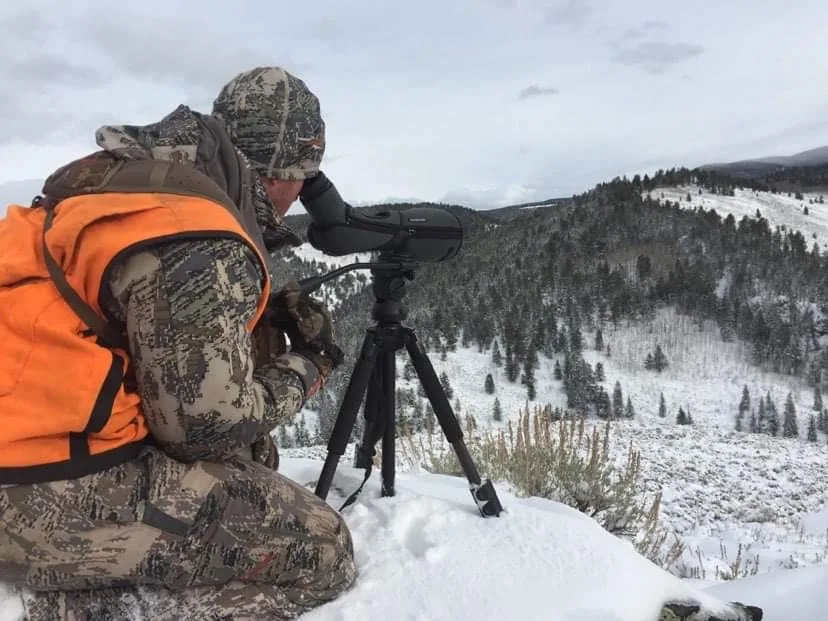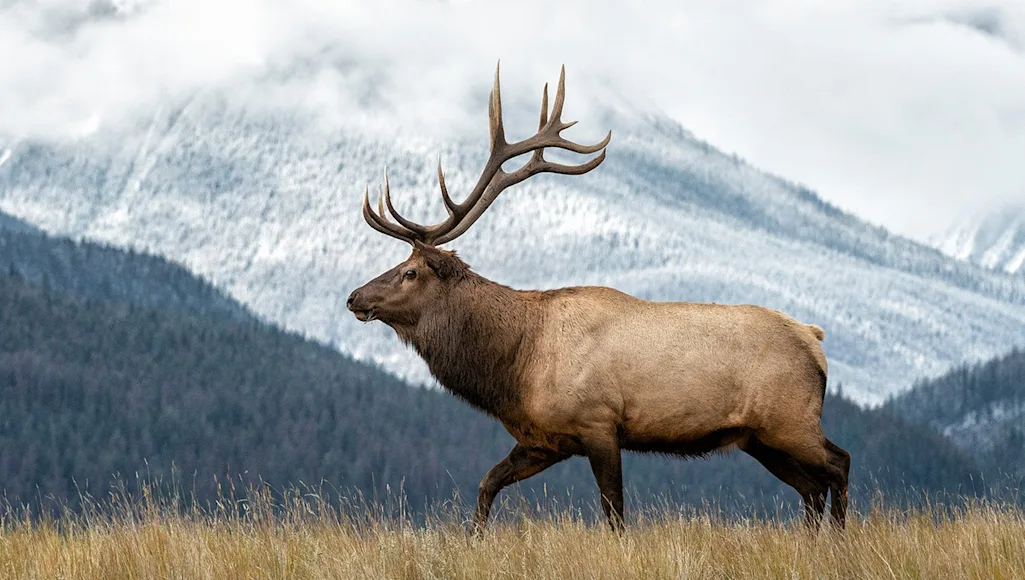_We may earn revenue from the products available on this page and participate in affiliate programs. Learn more ›
_
If you’re day dreaming about an upcoming elk hunt during rifle season, it probably looks something like this: A wall tent set in a small clearing surrounded by aspens trying to hold onto their last bits of gold. You and your buds inside, huddled around the stove, bs-ing and making plans for the morning’s hunt. And, as long as you’re conjuring up the ideal scene, you should also picture a fresh blanket of snow dusting the meadow grasses and blanketing the slopes around you.
Weather is everything when if comes to rifle-season elk hunting, and nothing promises to put bulls on their feet like a forecast that begins with a snowflake icon. So pray for the white stuff and follow this advice.
How Fresh Snow Affects Elk Movement

When snow hits the high country, one of the quickest ways to find elk is to simply get to a high spot and put your optics to work. Jace Bauserman
From August through May, snow can hit the high country at any time. During October and November, waking up to white on an elk hunt is almost a guarantee, and whether Mother Nature gives you a half inch or 6 inches, consider it a gift. Weather fronts move elk, and when the storm stops, you need to be out covering ground or posted up on an elevated ridge and glassing with quality optics.
Elk, especially those traveling in a herd, typically to drop in elevation if new snow measures several inches or more. They are simply moving to where food is more accessible. Older cows know where these locations are and will rally the herd—usually consisting of cows, calves, and smaller bulls—to beeline to the new spot. Unless the snow is measured in feet and not inches, larger bulls may not make such drastic movements. Still, these elk need to eat and will shift to south-facing slopes where forage is available and is easier to get at.
How to Find and Tag a Bull Elk After a Snowstorm

Elk guru Grafton Singer prefers to hunt bulls during October and November, when snow is common in the backcountry. Jace Bauserman
New snow in the high country gives you four big advantages as an elk hunter. Here’s what they are, how they help you, and what you should do to take make the most of each.
1. Snow makes elk easier to spot.
A 600-plus-pound animal with a tan hide and dark mane really stands out against a white backdrop. When the snow hits, my elk hunting companions and I will typically climb just a little above where we thing the elk are and spend hours moving from vantage point to vantage point, picking the country apart with optics. The key is positioning yourself in locations where you can see lots of ground. Don’t move from an area too quickly. Be sure and pick timber pockets apart, as these are great locations to find and put a bull or three to bed.
2. Fresh snow means perfect tracking conditions.
If you’re out burning boot leather when the snow stops and come across a set of lone bull prints or lots of tracks left by a herd, you know those tracks are smoking fresh. Don’t start following them aimlessly, though. Pull out your digital mapping app and look at the terrain. Is there an open meadow or sage flat ahead where the herd can paw down to some good forage? What about a semi-open south-facing mountainside where the sun is warming the ground? Put some thought into what the elk might do, and then make a plan of attack. When following tracks, don’t get mesmerized by them. Keep your eyes up—continually look up and ahead for a flash of tan. Each time the landscape changes, whether you topped a ridge or popped out of some tight timber, stop and glass ahead.
3. Snow quiets your approach.
Nothing makes for an ultra-stealthy stalking like fresh snow. If possible, try to spot elk from above and stalk downhill to them them. Carry a bottle of wind checker and puff it often to stay in tune with fickle mountain breezes. If you’re rifle hunting with a partner or two, take the time to develop a smart game plan where if one hunter bumps elk, the others are in position to take a safe shot, or are at least in place to glass and mark animals when they more.
One big thing to remember when stalking in the snow is that you become much more visible to elk. Blaze orange is a requirement in most elk-rich states during rifle season, and that blaze orange can look like the lights of the Vegas Strip when its set against a white background. If you spot elk but the cover is too sparse for stalking or you feel the stalk is a low percentage one, simple wait those elk out instead. Set up in a good ambush spot down- or crosswind of the elk, and be ready to capitalize when they get up to fill their bellies.
4. Snow makes bloodtrailing much easier.
Another solid bonus to snow is that blood and tracks will be easy to follow if you need to trail a hit animal. This means that even with a marginal hit, you are much more likely to get a lethal follow-up shot or recover you bull at the end of what would otherwise have been a difficult, if not futile, trail job. Remember, this is your dream hunt, and the perfect elk foray ends with you sitting behind your trophy.






